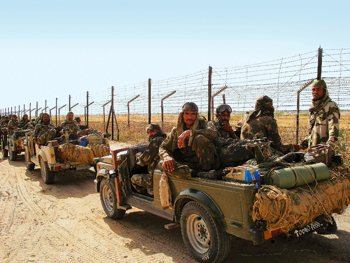INDIAN ARMED FORCES CHIEFS ON
OUR RELENTLESS AND FOCUSED PUBLISHING EFFORTS

SP Guide Publications puts forth a well compiled articulation of issues, pursuits and accomplishments of the Indian Army, over the years

I am confident that SP Guide Publications would continue to inform, inspire and influence.

My compliments to SP Guide Publications for informative and credible reportage on contemporary aerospace issues over the past six decades.
- Prime Minister witnesses 'Bharat Shakti' – a Tri-Services Firing and Manoeuvre Exercise in Pokhran, Rajasthan
- Interim Defence Budget 2024-25 — An Analysis
- Union Defence budget 2024
- Prime Minister Modi Commemorates Indian Navy Day in a Grand Ceremony
- Prime Minister Modi Flies in the LCA Tejas
- New Chapter in India-Italy Defence Ties
- Airpower beyond Boundaries
Border management: Key to curbing illegal activities

With the increasing mobility of people and goods in a globalised world, organised crime groups are making use of easy and convenient trans-border access to commit crimes. For this reason, border security management is a priority. Perpetrators of terrorism; trafficking in human beings, arms and drugs; environmental crime; fraud; identity theft and many other types of crime continuously change their modus operandi to avoid detection by national law enforcement agencies, but many of these crimes involve the physical crossing of a border by people or goods.
Take, for instance, India which has been having problems from across the border and hence needs to manage its borders much more effectively. India has 15,106.7 km. of land border and a coastline of 7,516.6 km. including island territories. Securing the country’s borders against interests hostile to the country and putting in place systems that are able to interdict such elements while facilitating legitimate trade and commerce are among the principal objectives of border management. The proper management of borders, which is vitally important for national security, presents many challenges and includes coordination and concerted action by administrative, diplomatic, security, intelligence, legal, regulatory and economic agencies of the country to secure the frontiers and subserve its best interests.
The Ministry of Home Affairs created the Department of Border Management in January 2004 to pay focused attention to the issues relating to management of international land and coastal borders, strengthening of border policing and guarding, creation of infrastructure like roads, fencing and flood lighting of borders and implementation of Border Area Development Programme (BADP).
The European Union (EU) has developed the concept of ‘Integrated Border Management’ which is key to the European border management strategy and presents key elements and activities for inclusion in International Organisation for Migration (IOM) Immigration and Border Management programming. IOM is increasingly called upon by European countries to assist in addressing complex border management challenges. Integrated Border Management requires that all competent authorities work together in an effective and efficient manner. Integrated Border Management seeks to address three levels of cooperation and coordination: intraservice cooperation, inter-agency cooperation and international cooperation.
A sub-concept of Integrated Border Management frameworks is the OneStop-Border-Post (OSBP). Even though a relatively new concept by title, OSBPs have been implemented in various ways and in many regions, implying a single, shared physical infrastructure in which the neighbouring countries’ customs/border services operate side by side. A parallel concept exists called ‘Coordinated Border Management’ (widely recognised by the customs community and the World Customs Organisation), with similar objectives to Integrated Border Management, which focuse more on the specifics of enhanced coordination and collaboration between customs with other non-state actors.
For instance, the US shares borders with Canada and Mexico and has joint declaration with both the countries. In 2011, President Barack Obama and Canadian Prime Minister Stephen Harper announced the United States-Canada joint declaration: Beyond the Border: A shared vision for perimeter security and economic competitiveness. The declaration articulates a shared approach to security in which both countries work together to address threats within, at, and away from its borders, while expediting lawful trade and travel.
High Turnover for Trans-border Crimes
The global border security market size was $16.3 billion in 2012, expected to increase to $32.5 billion by 2021. The intelligence, surveillance and reconnaissance segment will contribute more than 40 per cent to this market by 2021, according to Frost & Sullivan Global Border and Maritime Security Market Assessment, 2013.
It said that border security remains a more fragmented market, and has relied on human-intensive techniques, such as lookout posts, guards or paramilitaries. According to Frost & Sullivan, this will change over the forecast period with technology adoption and better ISR solutions being procured in the market.
It was revealed at the 2012 World Economic Forum that the cross-border flow of global proceeds from criminal activities, corruption and tax evasion is estimated at over $1 trillion. Illegal drugs and counterfeit goods each account for 8 per cent of the world trade. A coordinated approach is therefore essential to eliminate duplication of mechanisms and efforts and to improve border security management around the world.





